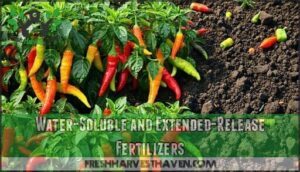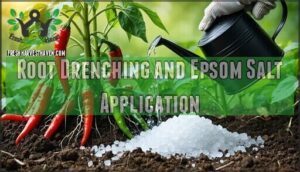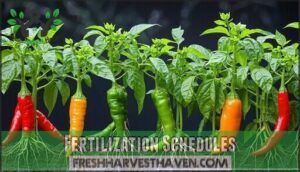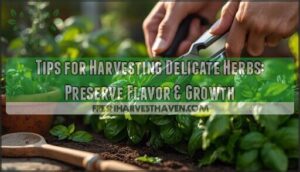This site is supported by our readers. We may earn a commission, at no cost to you, if you purchase through links.
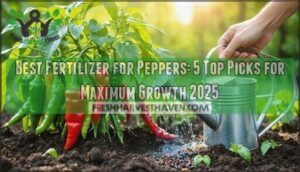
During early growth, use a balanced fertilizer like 10-10-10 to promote healthy foliage.
Once flowering begins, switch to a lower-nitrogen formula with higher phosphorus and potassium, such as 5-10-10.
Organic options like compost or fish emulsion work great, while synthetic fertilizers provide quick results.
Water-soluble fertilizers offer immediate nutrients, but slow-release granules feed plants steadily.
Don’t overdo it—peppers are like teenagers at dinner; they’ll take what they need, but too much causes problems.
The secret lies in timing your applications perfectly.
Table Of Contents
- Key Takeaways
- Choosing Best Fertilizer
- Fertilizer Types Explained
- 5 Best Fertilizers for Peppers
- Fertilizing Techniques
- Fertilization Schedules
- Avoiding Over-Fertilization
- Frequently Asked Questions (FAQs)
- What’s the best fertilizer for peppers?
- Is 20/20/20 fertilizer good for peppers?
- Can I fertilize peppers during cold weather?
- How does container size affect fertilizer needs?
- Should I fertilize peppers with yellowing leaves?
- What fertilizer works best for hot peppers?
- When should I stop fertilizing before harvest?
- Conclusion
Key Takeaways
- You’ll need different fertilizers for different growth stages – use balanced 10-10-10 during early growth, then switch to lower-nitrogen 5-10-10 when flowering begins to maximize fruit production.
- Test your soil’s pH first and aim for a 6.0-6.8 range, since peppers can’t absorb nutrients properly if your soil’s too acidic or alkaline, regardless of which fertilizer you choose.
- Don’t over-fertilize your peppers – too much nitrogen causes leafy growth but fewer peppers, and you’ll see warning signs like brown leaf tips and stunted growth if you’ve gone overboard.
- Time your fertilizer applications correctly by stopping 2-3 weeks before harvest to prevent excess nitrogen from affecting fruit flavor and ensure your peppers ripen with concentrated taste.
Choosing Best Fertilizer
You’ll need to understand your soil’s pH and nutrient needs before selecting the right fertilizer for your pepper plants.
Know your soil’s secrets before feeding your peppers – pH and nutrients hold the key to garden success.
The best fertilizer choice depends on your soil conditions, pepper growth stage, and whether you prefer organic or synthetic options, which can significantly impact the health and productivity of your plants, making complete concepts of soil and fertilizer crucial.
Understanding Soil PH
Why does your pepper garden’s success hinge on something you can’t see? Soil pH determines whether your plants thrive or struggle. This invisible factor controls nutrient availability like a gatekeeper.
Your soil’s pH is the invisible gatekeeper that decides whether your peppers will thrive or merely survive.
Here’s your pH roadmap:
- Test your soil using a pH meter or soil test kit
- Target 6.0-6.8 for ideal pH levels in pepper cultivation
- Adjust accordingly with lime for alkalinity or sulfur for soil acidity
Essential Nutrients for Pepper Plants
Understanding your soil’s pH sets the foundation, but knowing what nutrients your peppers actually need makes the difference between average and exceptional harvests.
Nitrogen’s role drives leafy growth and photosynthesis, while phosphorus importance shows in strong roots and flowering.
Potassium benefits include smooth water movement throughout the plant, and Calcium needs prevent blossom end rot.
Micronutrient impact affects overall plant health and pepper development.
Fertilizer Types Explained
You’ll encounter two main categories when shopping for pepper fertilizers: organic versus synthetic options, and water-soluble versus extended-release formulas.
Each type offers distinct advantages, so understanding these differences helps you choose the right fertilizer that matches your gardening style and your peppers’ specific needs.
Organic and Synthetic Fertilizers
You’ll face two main fertilizer choices for peppers: organic and chemical fertilizer options.
Organic fertilizer releases nutrients slowly through soil microbes, improving long-term effects on soil health.
Chemical fertilizer provides quick nutrient availability but may impact environmental concerns.
Cost comparison favors synthetics short-term, while organics offer better application ease and sustainable NPK delivery for fertilizing peppers long-term.
Water-Soluble and Extended-Release Fertilizers
Water-soluble fertilizers dissolve quickly in water, delivering nutrients fast to your pepper plants.
Extended-release fertilizers break down slowly over months, providing steady nutrition. Your choice depends on how hands-on you want to be with fertilizing peppers.
Here’s what makes each fertilizer type unique:
- Dissolving Rates – Water-soluble fertilizers dissolve instantly while extended-release types break down gradually over 3-6 months
- Nutrient Availability – Quick-acting formulas provide immediate macronutrients, but extended-release maintains consistent NPK levels
- Application Timing – Liquid pepper fertilizer needs weekly feeding, granular types require less frequent applications
- Cost Comparison – Extended-release costs more upfront but saves time and money long-term
For a variety of options, consider different fertilizer products.
5 Best Fertilizers for Peppers
You’ve learned about fertilizer types, and now it’s time to choose the right product for your pepper plants.
These five fertilizers offer different benefits, from organic options that improve soil health to liquid formulas that deliver quick results.
1. Espoma Organic Garden Tone Vegetable Fertilizer
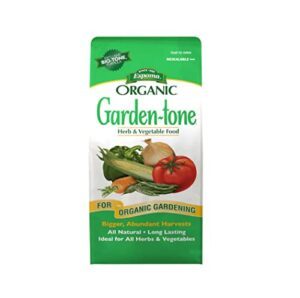
With over 95 years in the organic game, Espoma’s Garden Tone brings serious credentials to your pepper patch.
This 3-4-4 formula packs 5% calcium and their exclusive Bio-tone microbes that’ll boost nutrient uptake like nobody’s business.
You’ll get three pounds covering 50 square feet – just mix it into your top soil layers and you’re golden.
It’s OMRI-listed for organic gardens, so you can sleep easy knowing there’s no nasty stuff lurking around your future salsa ingredients, with the assurance of serious credentials.
Best For: Home gardeners who want an organic, environmentally safe fertilizer for leafy vegetables and warm-season crops like peppers and tomatoes.
- Organic and OMRI-listed for safe use in gardens.
- Contains 5% calcium and Bio-tone microbes for enhanced nutrient uptake.
- Easy application with no mixing required.
- May not provide the 5-10-10 NPK ratio recommended specifically for peppers.
- Requires monthly reapplication to maintain effectiveness.
- Not suitable for gardeners seeking synthetic or fast-acting fertilizers.
2. FoxFarm Liquid Nutrient Trio Soil Fertilizer
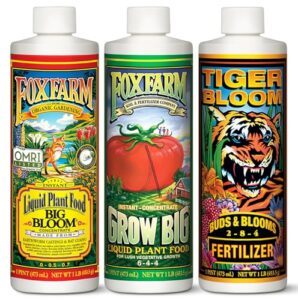
FoxFarm’s Liquid Nutrient Trio brings together three powerhouse fertilizers that’ll take your pepper plants from seedling to harvest.
You get Grow Big for lush vegetative growth, Big Bloom for healthy root development, and Tiger Bloom for abundant flowering and fruiting.
This OMRI-listed organic system adapts to each growth stage perfectly.
Simply mix the appropriate formula with water and apply directly to soil.
It’s like having a nutritionist for your peppers, delivering exactly what they need when they need it most.
Best For: Gardeners and growers looking for a comprehensive nutrient solution to support plant growth from seedling to harvest.
- Covers all growth stages from vegetative to flowering.
- Includes organic, OMRI-listed Big Bloom for eco-friendly care.
- Easy to use with a mix-and-apply system.
- Requires knowledge of plant growth stages for optimal use.
- Needs regular mixing and application with water.
- Not cost-effective for small-scale or occasional gardeners.
3. Miracle-Gro Organics Edibles Plant Food

When you need consistent nutrition for your pepper garden, Miracle-Gro Organics Edibles Plant Food delivers reliable results.
This OMRI-listed organic fertilizer feeds your plants instantly, making it perfect for busy gardeners who want maximum convenience without sacrificing quality.
You’ll apply it every seven days using either a watering can or the Performance Organics Garden Feeder.
The concentrated formula provides nutrients that beneficial soil microbes love, creating a thriving ecosystem around your pepper roots for up to six weeks of sustained feeding.
Best For: Busy gardeners looking for an organic, fast-acting plant food to support vegetables, herbs, fruits, and peppers.
- Needs to be applied every 7 days for best results.
- Overuse can harm plants due to concentrated formula.
- Limited to coverage of 265 sq. ft. per application.
- OMRI-listed organic and safe for edible plants.
- Provides instant feeding for quick results.
- Easy to apply with a watering can or feeder.
4. Miracle-Gro Organics Plant Food Granules
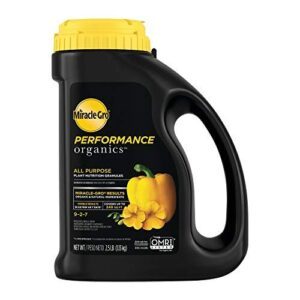
Convenience meets effectiveness with this granular fertilizer that’s perfect for busy gardeners.
You’ll shake the granules onto dry soil, gently mix them in, and water thoroughly.
The organic formula feeds your peppers for up to 240 square feet of garden space, delivering visible results in just seven days.
Reapply every 4-6 weeks throughout the growing season.
This shaker jug makes application foolproof – no measuring or mixing required, making it an ideal choice if you prefer set-and-forget fertilizing over frequent liquid applications, providing a convenient and effective way to fertilize your garden.
Best For: Busy gardeners looking for an easy-to-use organic fertilizer with quick results for various plants.
- Organic and natural ingredients promote healthy plant growth.
- Shaker jug design for easy, mess-free application.
- Visible results in just seven days.
- Requires consistent reapplication every 4-6 weeks.
- Needs watering after application for effectiveness.
- Limited to covering 240 square feet per shaker jug.
5. Black Gold Seedling Starter Mix
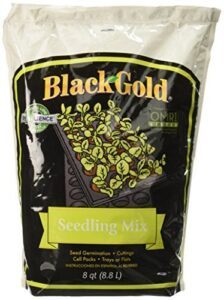
Starting seedlings right makes all the difference in your pepper garden’s success.
Black Gold Seedling Starter Mix delivers exactly what young pepper plants crave. This highly refined organic blend promotes strong root development with its low-salt, porous formula that retains moisture without drowning delicate roots.
The mix includes an organic wetting agent for even water distribution and RESiLIENCE enrichment for healthier starts. You’ll find it perfect for seed flats, pots, and plug trays, giving your pepper seedlings the foundation they need to thrive with a highly refined organic blend and strong root development.
Best For: Gardeners starting organic seedlings who need a reliable, moisture-retentive mix for strong root development.
- OMRI listed for organic use.
- Promotes strong root growth with optimal aeration and moisture retention.
- Includes organic wetting agent for uniform water penetration.
- Limited to an 8-quart volume, which may not suit large-scale planting.
- Requires careful storage to maintain integrity.
- May not be compatible with all seed types.
Fertilizing Techniques
You’ll get the best results from your pepper fertilizer when you apply it correctly using proven techniques.
Root drenching and foliar feeding are two effective methods that deliver nutrients directly where your plants need them most, utilizing techniques such as root drenching.
Root Drenching and Epsom Salt Application
Drenching pepper plants with Epsom salt delivers magnesium directly to roots, boosting plant health and fruit production.
Mix one cup of Epsom salt per gallon of water for your pepper plant fertilizer solution. Apply this root drenching technique monthly during growing season.
The magnesium benefits include improved nutrient absorption and stronger cell walls, making it essential for maximum root health. You can also find magnesium pepper products online to support your pepper plants’ maximum root health.
Fertilization Schedules
You’ll need to adjust your fertilization schedule based on your pepper plants’ growth stages, since seedlings require different nutrients than mature plants.
Timing your fertilizer applications correctly guarantees your peppers get the right nutrients when they need them most, leading to stronger growth and better harvests.
Seedling Stage Fertilization
When your pepper seedlings sprout their first true leaves, it’s time to introduce nutrients. Start with half-strength fertilizer containing balanced nitrogen and phosphorous to support healthy development.
Wait until those initial cotyledon leaves begin fading before beginning application timing. Consider using specialized seedling fertilizer for best results.
Your seedling’s nutrient needs are modest during this delicate stage, so gentle pepper fertilizer guarantees superior seedling health without overwhelming tender roots. This approach ensures healthy development and supports the overall growth of your pepper seedlings.
Vegetative and Flowering Stage Fertilization
Once your seedlings establish themselves, they’re ready for bigger nutritional demands. During the vegetative stage, you’ll need a nitrogen boost to fuel leafy growth, while the flowering stage requires phosphorus focus for bloom development. Stage-specific ratios make all the difference – think 20-10-10 for vegetation, then switch to 5-10-10 for flowering.
Key fertilization strategies:
- Apply nitrogen-rich pepper fertilizer every 3-4 weeks during vegetative growth
- Switch to pepper blooming fertilizer with higher phosphorus when flowers appear
- Use foliar applications of pepper fruiting fertilizer for quick nutrient absorption
Avoiding Over-Fertilization
Too much fertilizer can hurt your pepper plants just as much as too little, causing yellowed leaves and reduced fruit production.
You’ll learn to recognize the warning signs of nutrient burn and discover simple fixes to get your peppers back on track.
Signs of Nutrient Burn
Over-fertilizing shows up fast.
Watch for leaf tip burn – those crispy brown edges that scream trouble.
You’ll spot stunted growth, wilting leaves, and salt crust forming on your soil surface.
Brown leaves indicate nutrient burn, while salt deposits signal root damage.
These warning signs mean you’ve crossed the line from helpful feeding to harmful overdose.
Remedies for Over-Fertilization
When you spot those telltale signs of overfertilization, don’t panic.
Start by flushing soil with plain water to wash away excess nutrients. Reduce fertilizer amounts by half and adjust watering schedules to prevent future nutrient imbalance.
These simple remedies help your plants recover from leaf burning while you learn to diagnose burn symptoms early for better preventative measures.
Frequently Asked Questions (FAQs)
What’s the best fertilizer for peppers?
You’ll want a balanced fertilizer with an NPK ratio of 5-10-10 or 4-1-
Look for options containing calcium and magnesium too.
Water-soluble types work great, delivering nutrients directly to roots for healthier plants.
Is 20/20/20 fertilizer good for peppers?
Too much of a good thing can spoil the broth.
While 20-20-20 fertilizer works for peppers, it’s not ideal.
You’ll get excessive nitrogen, causing leafy growth but fewer peppers.
Choose 5-10-10 instead.
Can I fertilize peppers during cold weather?
Cold weather slows pepper growth substantially, so you shouldn’t fertilize during chilly periods.
Wait until temperatures consistently stay above 60°F and plants show active growth before resuming your regular feeding schedule.
How does container size affect fertilizer needs?
Container size dramatically impacts your pepper’s fertilizer appetite – smaller pots mean more frequent feeding since nutrients wash out faster, while larger containers hold nutrients longer, requiring less frequent applications.
Should I fertilize peppers with yellowing leaves?
Yes, fertilize peppers with yellowing leaves after identifying the cause.
Yellow leaves often indicate nitrogen deficiency or nutrient lockout from improper pH.
Test soil pH first, then apply balanced fertilizer if needed.
What fertilizer works best for hot peppers?
Hot peppers thrive with a 5-10-10 NPK fertilizer that’s lower in nitrogen but higher in phosphorus and potassium.
You’ll get better fruit production and heat levels with balanced feeding every 4-6 weeks throughout the growing season.
When should I stop fertilizing before harvest?
Like a conductor knowing when to lower the baton, you should stop fertilizing peppers 2-3 weeks before harvest.
This timing prevents excess nitrogen from affecting fruit flavor and guarantees your peppers ripen properly with concentrated taste, ensuring they have the best possible taste.
Conclusion
Perfect pepper harvests aren’t reserved for experienced gardeners with expensive equipment.
You’ve learned that choosing the best fertilizer for peppers depends on your plants’ growth stage and your gardening preferences.
Whether you select organic compost, synthetic blends, or water-soluble options, timing matters most.
Start with balanced nutrition during early growth, then switch to phosphorus-rich formulas when flowering begins.
Remember to avoid over-fertilization, monitor your plants closely, and adjust your feeding schedule based on their response for maximum yields.


